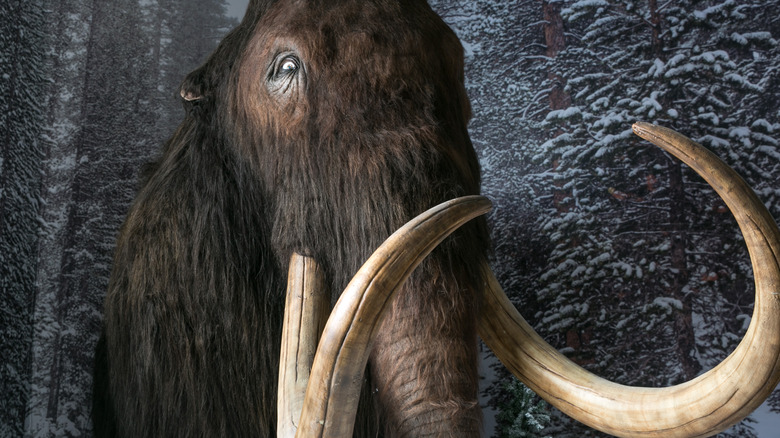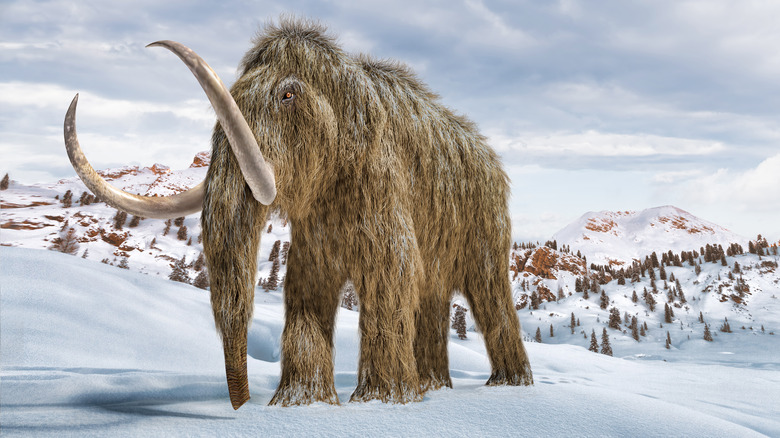We Could See The Return Of A Certain Prehistoric Creature In Our Lifetime
Menacing outcomes from the "Jurassic Park" film franchise have not given scientists any pause in their plans to bring back one extinct prehistoric creature, according to Popular Mechanics. In this case, the Dallas-based company, Colossal, won't revive a dinosaur — yet — but an enormous ice age animal (via The New York Times). National Geographic reports that the beast last walked the Earth some 10,000 years ago, though small populations are now believed to have survived until some 4,000 years ago, or around the same time as the pyramids in Egypt were being built (via ScienceDaily). Once blamed on humans, this animal's disappearance is now largely ascribed to climate change as global temperatures warmed at the tail-end of the last ice age.
The potential revival of this ancient species is only made possible by recent advances in DNA splicing technology, and the planned recreation of the extinct creature will hypothetically be accomplished using bits of DNA gathered from fossils. Whether or not an extinct species can be revived is a matter of much debate, as are the ethics of reintroducing an animal that died out thousands of years ago. Still, as Popular Mechanics explains, in early 2023, the company that intends to make these enormous creatures stride across the landscape once more received the additional funding it needs to make it happen within most people's lifetimes. If successful, the potential reanimated beast population could represent more than an amazing scientific accomplishment — it might also help counteract climate change.
Woolly mammoths are close relatives of Asian elephants
The proposed ice age creature is the woolly mammoth. Colossal hopes to revive it as soon as 2027, and it would be less of a clone and more of a genetic hybrid made possible with CRISPR-Cas9 DNA splicing technology, according to NPR. Theoretically, once mammoth DNA is genetically spliced with the Asian elephant — the mammoth's closest living relative — the embryo would then develop and end with the natural birth of a mammoth that would then return to its former habitat. To handle the numbers needed to establish a stable breeding population, artificial mammoth uteruses will likely be necessary, based on The New York Times report. Larger Asian elephants may also serve as surrogates.
An herbivore, woolly mammoths are known to have primarily lived in steppe tundra ecosystems across Eurasia and North America and some forested parts of the modern-day U.S. midwest (per Britannica). It's in the Eurasian area that Colossal thinks reintroduced woolly mammoths might have the most positive effect on climate change. The proposal raises many ethical and logistical questions, and there's little certainty about what might happen if Colossal is successful. Speaking with The New York Times, London School of Economics philosopher Heather Browning said, "You don't have a mother for a species that — if they are anything like elephants — has extraordinarily strong mother-infant bonds that last for a very long time. Once there is a little mammoth or two on the ground, who is making sure that they're being looked after?"
Scientists hoped to reintroduce the mammoth in Siberia
As The New York Times writes, scientists at the Texas-based company Colossal are hoping to genetically recreate the woolly mammoth and reintroduce the animal into the steppes of Siberia, an area that today is now showing negative signs of climate change. With herds of mammoths grazing in the area — grassland when mammoths were alive — the ecosystem might rebalance in several key ways as grasses trap carbon and slow the melting permafrost. Herds of bison have already been relocated to Siberia for similar purposes, but according to Colossal's plan, the much larger mammoth could be even more effective. As Popular Mechanics writes, geopolitical tensions in Russia caused by the 2022 Russian invasion of Ukraine could affect Colossal's vision.
If successful, there's also no guarantee that reversing the effects of climate might be the result, as NPR notes. Some in the scientific community argue that using modern DNA splicing technology to bolster endangered species still living today would be a better application. Still, Colossal received an additional $60 million in private funding in 2022 to see its project through, even if some experts say the net result will be less a real-life woolly mammoth than an extra hairy elephant with extra fat that's better adapted to the cold, via CNN. Thanks to Colossal, other extinct creatures like the thylacine or Tasmanian tiger also may once more walk the Earth. If there's little effect on the environment, they may still end up as an interesting attraction at the zoo.


